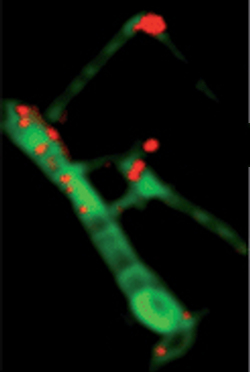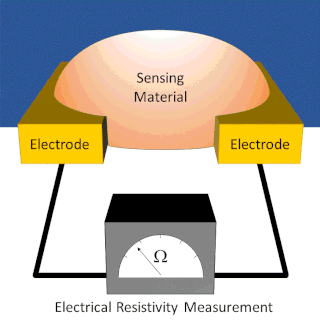Related Research Articles

Nanomaterials describe, in principle, chemical substances or materials of which a single unit is sized between 1 and 100 nm.

Nanobatteries are fabricated batteries employing technology at the nanoscale, particles that measure less than 100 nanometers or 10−7 meters. These batteries may be nano in size or may use nanotechnology in a macro scale battery. Nanoscale batteries can be combined to function as a macrobattery such as within a nanopore battery.
As the world's energy demand continues to grow, the development of more efficient and sustainable technologies for generating and storing energy is becoming increasingly important. According to Dr. Wade Adams from Rice University, energy will be the most pressing problem facing humanity in the next 50 years and nanotechnology has potential to solve this issue. Nanotechnology, a relatively new field of science and engineering, has shown promise to have a significant impact on the energy industry. Nanotechnology is defined as any technology that contains particles with one dimension under 100 nanometers in length. For scale, a single virus particle is about 100 nanometers wide.
The following outline is provided as an overview of and topical guide to nanotechnology:
Green nanotechnology refers to the use of nanotechnology to enhance the environmental sustainability of processes producing negative externalities. It also refers to the use of the products of nanotechnology to enhance sustainability. It includes making green nano-products and using nano-products in support of sustainability.

The optical properties of carbon nanotubes are highly relevant for materials science. The way those materials interact with electromagnetic radiation is unique in many respects, as evidenced by their peculiar absorption, photoluminescence (fluorescence), and Raman spectra.
Carbide-derived carbon (CDC), also known as tunable nanoporous carbon, is the common term for carbon materials derived from carbide precursors, such as binary (e.g. SiC, TiC), or ternary carbides, also known as MAX phases (e.g., Ti2AlC, Ti3SiC2). CDCs have also been derived from polymer-derived ceramics such as Si-O-C or Ti-C, and carbonitrides, such as Si-N-C. CDCs can occur in various structures, ranging from amorphous to crystalline carbon, from sp2- to sp3-bonded, and from highly porous to fully dense. Among others, the following carbon structures have been derived from carbide precursors: micro- and mesoporous carbon, amorphous carbon, carbon nanotubes, onion-like carbon, nanocrystalline diamond, graphene, and graphite. Among carbon materials, microporous CDCs exhibit some of the highest reported specific surface areas (up to more than 3000 m2/g). By varying the type of the precursor and the CDC synthesis conditions, microporous and mesoporous structures with controllable average pore size and pore size distributions can be produced. Depending on the precursor and the synthesis conditions, the average pore size control can be applied at sub-Angstrom accuracy. This ability to precisely tune the size and shapes of pores makes CDCs attractive for selective sorption and storage of liquids and gases (e.g., hydrogen, methane, CO2) and the high electric conductivity and electrochemical stability allows these structures to be effectively implemented in electrical energy storage and capacitive water desalinization.
A nanofluid is a fluid containing nanometer-sized particles, called nanoparticles. These fluids are engineered colloidal suspensions of nanoparticles in a base fluid. The nanoparticles used in nanofluids are typically made of metals, oxides, carbides, or carbon nanotubes. Common base fluids include water, ethylene glycol, and oil.

Rodney S. "Rod" Ruoff is an American physical chemist and nanoscience researcher. He is one of the world experts on carbon materials including carbon nanostructures such as fullerenes, nanotubes, graphene, diamond, and has had pioneering discoveries on such materials and others. Ruoff received his B.S. in chemistry from the University of Texas at Austin (1981) and his Ph.D. in chemical physics at the University of Illinois-Urbana (1988). After a Fulbright Fellowship at the MPI fuer Stroemungsforschung in Goettingen, Germany (1989) and postdoctoral work at the IBM T. J. Watson Research Center (1990–91), Ruoff became a staff scientist in the Molecular Physics Laboratory at SRI International (1991–1996). He is currently UNIST Distinguished Professor at the Ulsan National Institute of Science and Technology (UNIST), and the director of the Center for Multidimensional Carbon Materials, an Institute for Basic Science Center located at UNIST.
A nanogenerator is a compact device that converts mechanical or thermal energy into electricity, serving as an energy harvesting solution for small, wireless autonomous devices. It taps into ambient energy sources like solar, wind, thermal differentials, and kinetic energy, enabling power generation for applications such as wearable electronics and wireless sensor networks. Nanogenerators utilize ambient background energy readily available in the environment, such as temperature gradients from machinery operation, electromagnetic energy in urban areas, or even motion vibrations during activities like walking. This approach offers a means to power low-energy electronics without the need for conventional fuel sources.

Carbon nanotube supported catalyst is a novel supported catalyst, using carbon nanotubes as the support instead of the conventional alumina or silicon support. The exceptional physical properties of carbon nanotubes (CNTs) such as large specific surface areas, excellent electron conductivity incorporated with the good chemical inertness, and relatively high oxidation stability makes it a promising support material for heterogeneous catalysis.

A supercapacitor (SC), also called an ultracapacitor, is a high-capacity capacitor, with a capacitance value much higher than solid-state capacitors but with lower voltage limits. It bridges the gap between electrolytic capacitors and rechargeable batteries. It typically stores 10 to 100 times more energy per unit volume or mass than electrolytic capacitors, can accept and deliver charge much faster than batteries, and tolerates many more charge and discharge cycles than rechargeable batteries.
The applications of nanotechnology, commonly incorporate industrial, medicinal, and energy uses. These include more durable construction materials, therapeutic drug delivery, and higher density hydrogen fuel cells that are environmentally friendly. Being that nanoparticles and nanodevices are highly versatile through modification of their physiochemical properties, they have found uses in nanoscale electronics, cancer treatments, vaccines, hydrogen fuel cells, and nanographene batteries.
In materials science, MXenes are a class of two-dimensional inorganic compounds along with MBenes, that consist of atomically thin layers of transition metal carbides, nitrides, or carbonitrides. MXenes accept a variety of hydrophilic terminations. The first MXene was reported in 2011.

A chemiresistor is a material that changes its electrical resistance in response to changes in the nearby chemical environment. Chemiresistors are a class of chemical sensors that rely on the direct chemical interaction between the sensing material and the analyte. The sensing material and the analyte can interact by covalent bonding, hydrogen bonding, or molecular recognition. Several different materials have chemiresistor properties: semiconducting metal oxides, some conductive polymers, and nanomaterials like graphene, carbon nanotubes and nanoparticles. Typically these materials are used as partially selective sensors in devices like electronic tongues or electronic noses.
Apparao M Rao is the Robert A. Bowen Endowed Professor of Physics in the department of physics and astronomy, the founding director of the Clemson Nanomaterials Institute, and a former associate dean for discovery in the college of science at Clemson University. His research in nanoscience and nanotechnology has been cited over 54,600 times in open literature and his h-index is 98. He is a Fellow of the American Physical Society, the American Association for the Advancement of Science, the National Academy of Inventors, and the Materials Research Society. In 2012, he received the Alumni Award for Outstanding Achievements in Research, and has served on the Advisory Panel for the Dean and the Vice-President of Research, Clemson University. His research and development efforts led to the establishment of Clemson Nanomaterials Institute, which supports sustainable research and development capacity and competitiveness in the U.S. and the State of South Carolina. The State of South Carolina conferred on him its highest honor - the 2014 Governor’s award for excellence in scientific research.
A graphene morphology is any of the structures related to, and formed from, single sheets of graphene. 'Graphene' is typically used to refer to the crystalline monolayer of the naturally occurring material graphite. Due to quantum confinement of electrons within the material at these low dimensions, small differences in graphene morphology can greatly impact the physical and chemical properties of these materials. Commonly studied graphene morphologies include the monolayer sheets, bilayer sheets, graphene nanoribbons and other 3D structures formed from stacking of the monolayer sheets.
A graphene helix, similar to the carbon nanotube, is a structure consisting of a two-dimensional sheet of graphene wrapped into a helix. These graphene sheets can have multiple layers, called multi-walled carbon structures, that add to these helices thus increasing their tensile strength but increasing the difficulty of manufacturing. Using van der Waals interactions it can make structures within one another.

Zhong Lin Wang is a Chinese-American physicist, materials scientist and engineer specialized in nanotechnology, energy science and electronics. He received his PhD from Arizona State University in 1987. He is the Hightower Chair in Materials Science and Engineering and Regents' Professor Chair Emeritus at the Georgia Institute of Technology, US.
References
- ↑ "Ramakrishna Podila, Ph.D." Clemson University.
- ↑ "An all-carbon optical diode for photonic computing". Nanowerk.
- ↑ Anand, Benoy; Podila, Ramakrishna; Lingam, Kiran; Krishnan, S. R.; Siva Sankara Sai, S.; Philip, Reji; Rao, Apparao M. (2013-12-11). "Optical Diode Action from Axially Asymmetric Nonlinearity in an All-Carbon Solid-State Device". Nano Letters. 13 (12): 5771–5776. Bibcode:2013NanoL..13.5771A. doi:10.1021/nl403366d. ISSN 1530-6984. PMID 24224861.
- ↑ Pacha, Aswathi (2017-12-30). "Nanogenerators go wireless". The Hindu. ISSN 0971-751X.
- ↑ "Improving the energy storage in graphene with defects". Nanowerk.
- ↑ "Novel 2D spacer materials for surface plasmon coupled emission sensing". Nanowerk.
- ↑ "Smartphone-based nano-biosensors for early detection of tuberculosis". Nanowerk.
- ↑ Persaud, Indushekhar; Raghavendra, Achyut J.; Paruthi, Archini; Alsaleh, Nasser B.; Minarchick, Valerie C.; Roede, James R.; Podila, Ramakrishna; Brown, Jared M. (March 2020). "Defect-induced electronic states amplify the cellular toxicity of ZnO nanoparticles". Nanotoxicology. 14 (2): 145–161. doi:10.1080/17435390.2019.1668067. ISSN 1743-5404. PMC 7036006 . PMID 31553248.
- ↑ "Batteries created by Clemson scientists could eventually help astronauts on Mars". A. B. C. News 4. 31 August 2020.
- ↑ "CU scientists create multipurpose batteries that could make it easier to get around on Mars". Clemson University. 31 August 2020.
- ↑ "Indian-origin Scientists Develop Lighter, Fast-charging Batteries that Can Power Mars Rover". News18. 3 September 2020.
- ↑ "Clemson researchers blaze new ground in wireless energy generation for future electronic gadgets". Clemson University.
- ↑ Mallineni, Sai Sunil Kumar; Behlow, Herbert; Dong, Yongchang; Bhattacharya, Sriparna; Rao, Apparao M.; Podila, Ramakrishna (2017-05-01). "Facile and robust triboelectric nanogenerators assembled using off-the-shelf materials". Nano Energy. 35: 263–270. Bibcode:2017NEne...35..263M. doi:10.1016/j.nanoen.2017.03.043. ISSN 2211-2855.
- ↑ "A new breakthrough in lithium-silicon batteries". Nanowerk.
- ↑ Pacha, Aswathi (2018-05-07). "Carbon nanotubes could revolutionise Li-ion batteries, say researchers". The Hindu. ISSN 0971-751X.
- ↑ "Lower Cost, Roll-to-Roll Production of Carbon Nanotube Based Supercapacitors". InterNano.
- ↑ "Clemson research could lead to therapeutic strategies to combat Alzheimer's, Type 2 diabetes and other diseases". Clemson University News and Stories, South Carolina. 29 June 2020.
- ↑ "Triboelectric device bypasses injured nerves to restore sense of touch". American Chemical Society.
- ↑ Raghavendra, Achyut J; Gregory, Wren E; Slonecki, Tyler J; Dong, Yongchang; Persaud, Indushekhar; Brown, Jared M; Bruce, Terri F; Podila, Ramakrishna (2018-07-23). "Three-photon imaging using defect-induced photoluminescence in biocompatible ZnO nanoparticles". International Journal of Nanomedicine. 13: 4283–4290. doi: 10.2147/IJN.S165201 . ISSN 1176-9114. PMC 6061205 . PMID 30087560.
- ↑ "Clemson Nanomaterials Center reaches out to community". Clemson University. 2 April 2015.